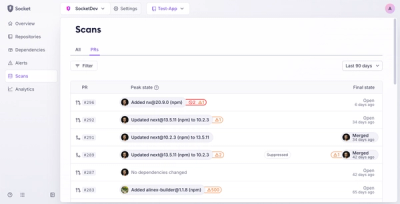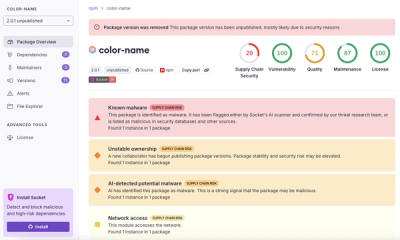
Product
Introducing Pull Request Stories to Help Security Teams Track Supply Chain Risks
Socket’s new Pull Request Stories give security teams clear visibility into dependency risks and outcomes across scanned pull requests.
@ln-zap/testcafe-browser-provider-electron
Advanced tools
TestCafe browser provider plugin for testing applications built with Electron.
Use this plugin to test Electron applications with TestCafe.
npm install testcafe-browser-provider-electron
If your JavaScript application runs in Electron, follow these steps to set up testing.
Create a .testcafe-electron-rc file in the root application directory. Include the following settings to this file.
{
"mainWindowUrl": "./index.html"
}
An Electron app has a file that is loaded as a startup page. TestCafe waits until Electron loads this page and then runs tests. Specify the path to this file with mainWindowUrl option. If a relative path is specified, it is resolved from the .testcafe-electron-rc file location.
For information about other options, see the Configuration section.
Install the Electron module of the required version.
npm install electron@latest
The command above installs the latest version of the Electron executable.
Define the path to the config file. Use browser provider postfix: electron:<path_to_testcafe-electron-rc_directory>. Then run tests.
testcafe "electron:/home/user/electron-app" "<tests_directory>/**/*.js"
The .testcafe-electron-rc file might be not in the application root directory. In that case specify the path to the configuration file like this:
{
"mainWindowUrl": "./index.html",
"appPath": "/home/user/my_app"
}
In this instance, the appPath directory will be used as a working directory of the Electron application.
If your Electron app is built it has <your_app_name>.exe or electron.exe file. In that case you don't need an Electron module to run tests. Perform the following steps instead.
In the application directory, create a .testcafe-electron-rc file with the following settings.
{
"mainWindowUrl": "./index.html",
"electronPath": "/home/user/myElectronApp/electron"
}
mainWindowUrl points to the application startup page; electronPath defines the path to your application's executable file. If you specify relative paths, they will be resolved from the .testcafe-electron-rc file location.
When you run tests, define the path to the configuration file. To do so, add the browser provider postfix: electron:<path_to_testcafe-electron-rc_directory>.
testcafe "electron:/home/user/electron-app" "<tests_directory>/**/*.js"
To launch tests through the API, specify the application path with electron: prefix and pass it to the browsers method.
testCafe
.createRunner()
.src('path/to/test/file.js')
.browsers('electron:/home/user/electron-app')
.run();
In most cases, the target webpage is the main application page specified via the mainWindowUrl configuration option.
{
"mainWindowUrl": "./index.html"
}
fixture `Electron test`
.page('./index.html');
However, you can specify any application page if your app contains more than one.
fixture `Electron test`
.page('./views/detail.html');
You can specify the following options in the .testcafe-electron-rc configuration file.
Required. Specifies the URL of the application's main window page. For local application pages, you can also specify a relative (to the application directory) or an absolute path to the file of the page.
Optional. Alters path to the application, which, by default, must be located at the default Electron app directory.
You can use the appPath option to override the default path by specifying a new absolute path. Alternatively, you can append a relative path to the path specified after the "electron:" prefix.
Optional. Overrides application command line arguments with the values specified in this option. It should be an array or an object with numeric keys.
Optional. Specifies a path to the electron binary. If electronPath is not specified, the electron package should be installed.
On macOS, it can be either a path to the electron binary, or a path to the entire Electron.app (e.g. /Applications/Electron.app). It may be necessary to stop all other running
instances of the specified Electron binary.
Optional. testcafe-browser-provider-electron suppresses did-navigate and will-navigate webContent events because you will be unable to run tests if these events are used to prevent navigation. You can enable them back by setting this option to true.
Optional. If true, DevTools will be opened just before tests start.
You can use helper functions from the provider in your test files. Use ES6 import statement to access them.
import { getMainMenu, clickOnMenuItem } from 'testcafe-browser-provider-electron';
Gets a snapshot of the specified application's main menu item.
async function getMainMenuItem (menuItemSelector)
| Parameter | Type | Description |
|---|---|---|
menuItemSelector | String | An array of menu item labels and/or objects with properties "label" and "index". |
For example, you can pass the following values in the menuItemSelector parameter.
['File', 'Open']['File', { label: 'Open' }]Context Menu > UndoIf there are several menu items with the same label on the same level, you can specify a one-based "index" property:
['Window', {label: 'My Window', index: 2}]This value corresponds to the second menu item with label My Window in the Window menu.
Check the properties available in the snapshot here.
Example
import { getMainMenuItem } from 'testcafe-browser-provider-electron';
fixture `Electron test`
.page('./index.html');
test('Check the menu item role', async t => {
const menuItem = await getMainMenuItem(['Main Menu', 'Edit', 'Undo']);
await t.expect(menuItem.role).eql('undo');
});
Gets a snapshot of the specified menu item from the most recently opened context menu.
async function getContextMenuItem (menuItemSelector)
| Parameter | Type | Description |
|---|---|---|
menuItemSelector | String | An array of menu item labels and/or objects with properties "label" and "index". |
For example, you can pass the following values in the menuItemSelector parameter.
['Go To', 'Declaration']['Go To', { label: 'Declaration' }]If there are several menu items with the same label on the same level, you can specify a one-based "index" property:
['Go To', {label: 'My Function', index: 2}]This value corresponds to the second menu item with label My Function in the Go To submenu.
Check the properties available in the snapshot here.
Example
import { getContextMenuItem } from 'testcafe-browser-provider-electron';
fixture `Electron test`
.page('./index.html');
test('Check the menu item role', async t => {
await t.rightClick('.el');
const menuItem = await getContextMenuItem(['Go To', {label: 'My Function', index: 2}]);
await t.expect(menuItem.visible).ok();
});
Gets an array of snapshots of the application's main menu items. If an item has a submenu, it will also be represented as an array of snapshots.
async function getMainMenuItems ()
You can check properties available in snapshots here.
Example
import { getMainMenuItems } from 'testcafe-browser-provider-electron';
fixture `Electron test`
.page('./index.html');
test('Menu should contains the proper list of items', async t => {
const menuItems = (await getMainMenuItems()).map(item => item.label);
await t.expect(menuItems).eql(['File', 'Edit', 'Help']);
});
Gets an array of item snapshots from the most recently opened context menu. If an item has a submenu, it will also be represented as an array of snapshots.
async function getContextMenuItems ()
You can check properties available in snapshots here,
Example
import { getContextMenuItems } from 'testcafe-browser-provider-electron';
fixture `Electron test`
.page('./index.html');
test('Context menu should contains the proper list of items', async t => {
await t.rightClick('.element-with-context-menu');
const menuItems = (await getContextMenuItems()).map(item => item.label);
await t.expect(menuItems).eql(['Cut', 'Copy', 'Properties']);
});
Performs a click on the specified main menu item (menuItem).
async function clickOnMainMenuItem (menuItem, modifiers)
| Parameter | Type | Description |
|---|---|---|
menuItem | String | Object | The main menu item to click. |
modifiers | Object | Control keys held when clicking the menu item. |
If you specify a string in the menuItem parameter, it will be passed to the getMainMenuItem function and the returned value will be used. Alternatively, you can pass a value returned by the getMainMenuItem or getMainMenuItems function.
Use the modifiers parameter to specify state of the control keys (Shift, Ctrl, Alt, Meta). The default value is
{
"shift": false,
"ctrl": false,
"alt": false,
"meta": false
}
Examples
import { clickOnMainMenuItem } from 'testcafe-browser-provider-electron';
fixture `Test Electron`
.page('./index.html');
test('Should open search panel', async t => {
await clickOnMainMenuItem(['Main Menu', 'Edit', 'Find...']);
await searchPanel = Selector('.search-panel');
await expect(searchPanel.count).eql(1);
});
import { clickOnMainMenuItem, getMainMenuItems } from 'testcafe-browser-provider-electron';
fixture `Test Electron`
.page('./index.html');
test('Should create new file', async t => {
await clickOnMainMenuItem(['File', 'New']);
//Or
await clickOnMainMenuItem((await getMainMenuItems())[0].submenu[0])
await newFile = Selector('.file-item').withText('New File');
await expect(newFile.count).eql(1);
});
Performs a click on the specified menu item (menuItem) of the most recently opened context menu.
async function clickOnContextMenuItem (menuItem, modifiers)
| Parameter | Type | Description |
|---|---|---|
menuItem | String | Object | The main menu item to click. |
modifiers | Object | Control keys held when clicking the menu item. |
If you specify a string in the menuItem parameter, it will be passed to the getContextMenuItem function and the returned value will be used. Alternatively, you can pass a value returned by the getContextMenuItem or getContextMenuItems function.
Use the modifiers parameter to specify state of the control keys (Shift, Ctrl, Alt, Meta). The default value is
{
"shift": false,
"ctrl": false,
"alt": false,
"meta": false
}
Examples
import { clickOnContextMenuItem } from 'testcafe-browser-provider-electron';
fixture `Test Electron`
.page('./index.html');
test('Should open properties of element', async t => {
await t.rightClick('.el');
await clickOnContextMenuItem(['Properties...']);
await elPropsPanel = Selector('.item-properties-panel');
await expect(elPropsPanel.count).eql(1);
});
Sets a function that will handle native Electron dialogs.
async function setElectronDialogHandler (handler, dependencies)
| Parameter | Type | Description |
|---|---|---|
handler | Function | A function that will handle Electron dialogs. |
dependencies | Object | Variables passed to the handler function's scope as global variables. |
The handler function has the following signature.
function handler (type, ...args)
This function must be synchronous. It will be invoked with the dialog type type, and the arguments args
from the original dialog function.
The type parameter takes one of the following values:
open-dialog,save-dialog,message-box,error-box,certificate-trust-dialog.Example
import { setElectronDialogHandler } from 'testcafe-browser-provider-electron';
fixture `Electron test`
.page('./index.html');
test('Test project opening', async t => {
await setElectronDialogHandler((type, browserWindow, options) => {
//browserWindow, options are standard arguments of the opening dialog, you can use it for your purposes
if(type !== 'open-dialog')
return;
//it returns the file path from the open dialog
return ['/home/user/project_name'];
});
await t
.click('.open-project')
//Here the open directory dialog opens and returns the path '/home/user/project_name'
//After this, we check that the project was opened to get its name
.expect('.project-name').eql('project_name');
});
Developer Express Inc. (https://devexpress.com)
FAQs
TestCafe browser provider plugin for testing applications built with Electron.
We found that @ln-zap/testcafe-browser-provider-electron demonstrated a not healthy version release cadence and project activity because the last version was released a year ago. It has 5 open source maintainers collaborating on the project.
Did you know?

Socket for GitHub automatically highlights issues in each pull request and monitors the health of all your open source dependencies. Discover the contents of your packages and block harmful activity before you install or update your dependencies.

Product
Socket’s new Pull Request Stories give security teams clear visibility into dependency risks and outcomes across scanned pull requests.

Research
/Security News
npm author Qix’s account was compromised, with malicious versions of popular packages like chalk-template, color-convert, and strip-ansi published.

Research
Four npm packages disguised as cryptographic tools steal developer credentials and send them to attacker-controlled Telegram infrastructure.